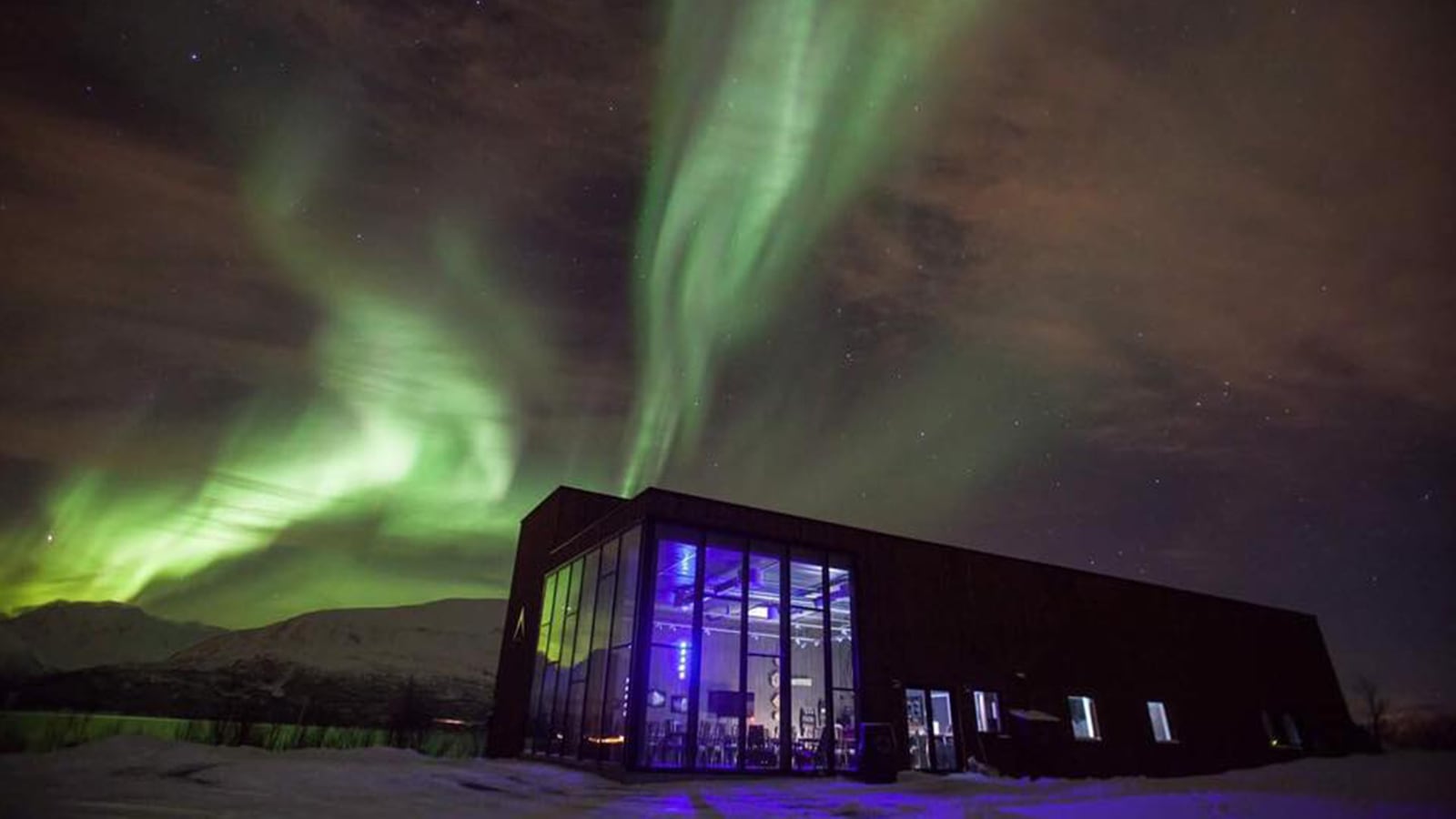We edge in past the heavy iron doors, along the tunnels, ghosts whispering over our shoulders. Ahead, a red light shines on oscillators, hot lines, and silent ticker tape machines. Soiled uniforms hang limp from hooks. A Perspex map in the control room shows the rugged coast we’ve just traveled.
We’re in the haunted passageways of an abandoned NATO base in Norway’s sliver of the Arctic Circle. This was part of Germany’s impenetrable Lyngen Line during the Second World War and was speedily expanded into the NATO’s northern line of defense against the U.S.S.R. during the Cold War.
“We’re not quite sure what to do with it,” admits Colin Houston, Aurora Spirits U.K. managing director. Ideas come out of the red-lit gloom, “warehousing? Tasting events? Murder mysteries? Avant-garde music festivals?” The last (mine) doesn’t go over too well—despite Norway’s rightful claim to be a hotbed of such activities.
Wandering around an ex-military base may seem odd. Wandering around one in the Arctic Circle with a distillery next to it is truly unique. Then again, nothing about Aurora is your standard whisky distillery story. This is the literally the most northern distillery in the world.
As such, it’s not the easiest place to reach. My flight from Oslo to Tromsø was delayed, which meant I missed the last ferry of the day to the end of the earth. Instead, the firm’s co-founder Hans-Olav Eriksen picked me up at the airport. “It’s the long way round,” he said. “About two hours… depending on how fast I drive.” He grins in a slightly manic fashion and we head off into the dark night over snow and ice at an alarming rate. I channel my inner Viking, settle back and listen to the saga of how he fell in love with single malt whisky and proceeded to spend most of his savings on Scotch. This all happened without telling his wife. (This last detail would become a recurring theme during our conversation.)
A trip to Islay, the small island off the west coast of Scotland that boasts an inordinate number of distilleries, confirmed his plan to make whisky with a group of like-minded individuals, in, of all places, the Arctic. Built in 2014, the distillery building is sleekly modern with a clean functional production space.
Distiller Gjermund Stensrud was the former master brewer at Tromsø’s Mack Brewery and the whisky’s wash is made, to his specs, at their new plant from quick-growing Finnish barley. After a week-long fermentation, 8,500 liters of the so-called distiller’s beer are trucked to the distillery and distilled in seven or eight batches in a Kuthe Still.

“The pot sits inside a water bath,” Stensrud explains, “and because there’s no direct heat, there’s no burning, allowing you to capture the sweetness and give more copper contact to help remove heavy elements… You’ve seen this stuff before. Let’s just try some.”
Another old iron door creaks open, revealing a warehouse with quarter casks, some barrels and a range of casks that previously held sherry, Sauternes and Madeira.
At six months, the spirit has all the cleanliness you expect from this type of still along with a hint of cereal and an intense, if light, fruitiness and a herbal, almost heathery, element. A peated variant (made with Scottish barley) shows a hint of menthol, with a nutty, wood smoke element and again that herby, heathery sweetness on the mid palate. This liquor is definitely one to watch.
Later that night there’s a flicker of green in the sky above us as we sit, hats on, in our own warm water bath drinking cold beer. Lots of cold beer. The aurora pulses into life, ribboning across the heavens, as the Norse gods’ Bivröst travels along the pathway between earth and Asgard.
“This Jacuzzi is the boardroom,” says Tor Petter Christensen, who, at this particular moment, isn’t exactly dressed like your conventional CEO. “This is where all of the decisions and ideas are formed.” As the conversation meanders, it turns out that the distillery was only one of Hans-Olav Eriksen’s projects. He’d already formed the Arctic activity company Lyngsfjord Adventure, and built its base, Camp Tamok. There will soon also be a bar and then, probably, a hotel in Tromsø. As ever, his long-suffering wife was the last to know.
While the whisky rests Aurora has launched three spirits under the Bivröst brand: a vodka that is flavored with local berries, a gin and an excellent aquavit. Stensrud is also experimenting with other spirits, including a frankly incredible one made from sea kelp.
“The distillery made sense when I visited Scotland,” Eriksen says. “I saw the way in which whisky is part of the hospitality industry there. I thought, we have to do the same here and make Northern Norway a destination with quality tourist offerings. To show our culture.” That’s where Colin Houston came in. He had 25 years of experience in hospitality in Scotland, as a hotelier and then in charge of quality assurance for tourism organization Visit Scotland.
We chat on. At one point, Tor Petter, who is a keen scuba diver, (yes, in the Arctic), suggests aging casks in the fjord. Eriksen suggests we go down and dip our toes in the frigid water. We resist and instead continue talking about their hopes for the distillery. “It’s telling people of the culture here, what being North Norwegian is,” says Petter. “You know,” he says while he raises his can towards me, “we are very similar to you Scots.”
“Yes,” calls out Eriksen, “we have a dark sense of humor!”
Aurora isn’t even the first Arctic whisky. That honor belongs to Myken. I first met its founders Roar Larsen and Trude Tokle back in 2013. “We’re building a distillery on an island, in the Arctic” was their opening gambit. That sure got my attention, especially when they then told me that Myken is 20 miles off the coast, which is a 90-minute sail on the speediest of boats.

Larsen and Tokle fell in love with the place after being stormbound for five days there while on a sailing trip. They ended up staying for a year with their family and began to think of ways to revitalize an economy, which was wholly reliant on summer visitors like themselves. The Myken archipelago used to support 50 people. In recent years, this went down to half a dozen. How many are there now? “15, and we’ll be moving there permanently once the kids have finished school,” answers Tokle, when we meet up in Tromsø.
We continue chatting. “Did I say 15?” she interjects. “Sorry! I was including a cat!” Island life. Gotta love it.
They weren’t exactly coming in as beginners. Larsen was chief scientist at Trondheim’s Sintef Institute, specializing in hydrates and working on desalination (hold that thought) and so knew his way around the principles of distillation. In 2014, they converted an old fish factory into a distillery. In went fat-bellied pot stills made by Hoa in Spain, looking like old Moorish alembics, and a desalination plant. As there’s not a bountiful supply of fresh water on this rocky outcrop, Larsen used his expertise to use seawater for mashing and condensing. Might that explain the mineral edge to the new, three-year-old whisky? It is fresh, lightly fruity and sweet with a rounded, fleshier mid-palate than the Aurora. The distillery’s peated version shows even greater promise. With talks starting with a farmer on the mainland about growing barley for them and casks coming from pioneering Swedish cooper Johan Thorslund, Myken is well set.

The next day, I squeeze the throttle of the snowmobile and race over the tundra into the frozen horizon. It’s silent except for the cough of a ptarmigan and the faint cries of huskies. Spindly beeches grow like ink scratches on a white page. A blank canvas, a place of opportunity. Why not make whisky here?
Don’t call them mad, because we are the mad ones for thinking whisky couldn’t, or even more arrogantly shouldn’t, be distilled in the Arctic.
The key isn’t the ‘why?’, but the ‘how?’ and not just in production, but the manner in which it syncs with local Norse and Sami cultures, and their different foods, fruits and even types of smoke. I remember one of my 4 AM Bivröst-induced suggestions of suspending a smoked reindeer heart in the still to make a Norse version of the Mexican mezcal pechuga, whose production usually involves a chicken breast. Like the sound festival idea it sank without trace. Maybe rightly, but these questions surely have to be asked.
Whisky is about more than just saying, “we are the most northerly, or from the most remote island. That has to be followed with, “… and therefore…” leading into the reasons for choosing site, the impact of climate, wood types, smokes, condensing and warehouse temperature, and how the location influences the mindset and the culture.
In this place where winter days are a permanent rainbow of pink and gold, and nights are lit by the Bivröst, there is a sense that nothing is impossible. A place for practical dreamers, bringing in a new life to the Arctic.






